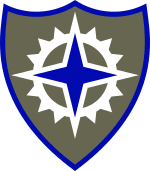XVI Corps (United States)
| XVI Corps | |
|---|---|
|
Shoulder sleeve insignia of XVI Corps | |
| Active |
7 December 1943 – 7 December 1945 April 1951 – 20 November 1954 22 November 1957 – 30 April 1968 |
| Country |
|
| Branch |
|
| Type | Corps |
| Engagements | World War II |
| Commanders | |
| Notable commanders |
John B. Anderson (1943-1945) Samuel Tankersley Williams (1953-1954) |
| U.S. Corps (1939 - Present) | |
|---|---|
| Previous | Next |
| XV Corps (United States) | XVII Corps (United States) |
The XVI Corps of the U.S. Army was initially constituted on 1 October 1933 as part of the Organized Reserves, and was activated on 7 December 1943 at Fort Riley, Kansas. During the Second World War, XVI Corps fought in the European Theater of Operations as part of the Ninth United States Army.
After the end of the war the corps was inactivated on 7 December 1945 at Camp Kilmer, New Jersey.
XVI Corps was reactivated in April 1951 as the Far East Command reserve.[1] Following its reactivation in May 1951, XVI US Corps was headquartered at Sendai, Japan, until it was inactivated there on 20 November 1954. The Corps mission was to control Divisions and other units attached to it by Far East Command. Elements of 40th and 24th IDs and 1st Cav. Div. under XVI US Corps control were stationed at Camp Schimmelpfennig from 1951 until after the Corps was inactivated.
Major General Kermit L. Davis wrote: '.. "I was then assigned as CG, XVI Corps, in Omaha, in charge of the Reserves of Kansas, Nebraska, Colorado, and Wyoming. This turned out to be mostly fire suppression, because ..Robert McNamara had just announced the Reserves should be merged with the National Guard. I had to try to convince my 27,000 reservists that he didn’t really mean it. Nobody believed me, and I spent a frustrating two years smoothing ruffled political feathers. Powerful politicians prevented the merger, ..'
The corps was active again from 22 November 1957 until 30 April 1968 at Omaha, Nebraska.
Campaign credits
- Rhineland
- Central Europe
Commanders
- Maj. Gen. John B. Anderson (December 1943 – October 1945)[2]
- Maj. Gen. Thomas D. Finley (October 1945 - December 1945)
- Maj. Gen. Roderick R. Allen (August 1951 - 1952)
- Maj. Gen. Clovis E. Byers (1952 - 1952)
- Maj. Gen. Blackshear M. Bryan (1952 - August 1953)
- Maj. Gen. Samuel T. Williams (August 1953 - November 1954)
Artillery commander
- Brig. Gen. Charles C. Brown (December 1943 – December 1945)
Notes
- ↑ Stars and Stripes
- ↑ arlingtoncemetery.net
References
- Clay, Steven E., (2010). "U.S. Army Order of Battle 1919 – 1941". Volume 1. Fort Leavenworth: Combat Studies Institute Press.
- Stanton, Shelby L., (1991). "World War II Order of Battle". New York: Galahad Books.
- Wilson, John B., compiler (1999). "Armies, Corps, Divisions, and Separate Brigades". Washington, D.C.: Government Printing Office. ISBN 0-16-049994-1.
